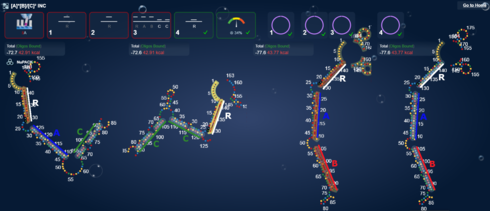A while back I was asked how I designed my A*B/C^2 puzzles, and at the time I couldn’t remember. A few days working on round 4 seems to have refreshed my memory and I think I can answer now.
This time around my paper designs did serve as a good starting point, and this one in particular resulted in a INC solution for me and a DEC solution for Astromon.
A little disclaimer here, when putting together these “paper” designs, I don’t use exact math. I write the oligos down on paper and see where they could share lanes. And I don’t want them sharing to big or to small of a lane. And by “lane” I mean reverse complements in the design sequence. And of course the shared lanes are not perfect matches, this is where I have to ballpark, or estimate. If I come to a point where there is no complementary sequence for both oligos sharing a lane, I know one or the other states is going to have a bulge or an internal loop. And I’ve found these bulges and loops come in very handy later on when it’s time to “balance” the oligos. So if in a shared lane the [C] oligo will be missing a bond, further down the line I will chose to match [C] over matching [A] or [B], maintaining a rough balance.
Another thing I am shooting for in my paper design is a scheme for part of the reverse complements of each [A] and [B] to be able to form a static stem, or crash together in states 1-3. In the diagram I labeled them Magnets.




























